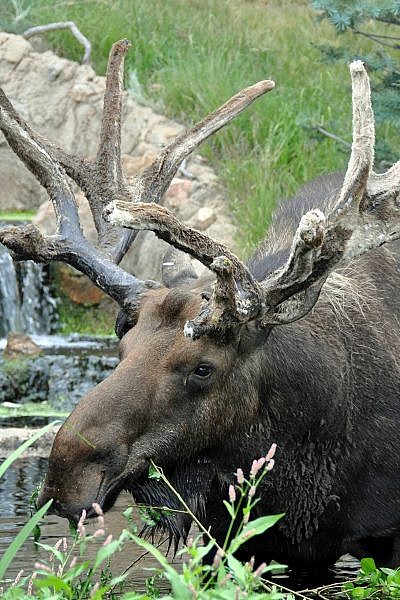This weekend, the Cheyenne Mountain Zoo family said a difficult goodbye to Tahoma, our well-loved friend and colleague in the fight to save wildlife.
“We strongly believe all of our animals have a very important job to do,” said Bob Chastain, president and CEO of Cheyenne Mountain Zoo. “They are ambassadors for their wild counterparts. They do the yeoman’s work of inspiring millions of people to understand and care about the challenges wild animals face.”
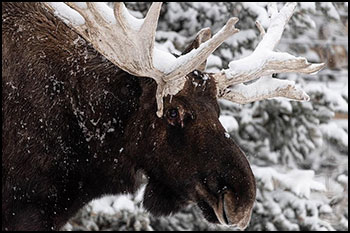
We humans are the best chance animals have for thriving in the wild. Tahoma helped tell the stories that inspired people to help. He encouraged people to do things like buying a hunting or fishing license, paying state park entrance fees, reducing mining by recycling, saving water and contributing to conservation efforts. Every visit to the Zoo is conservation in action. Tahoma’s CMZoo fans raise money and vote for conservation projects around the world through a portion of their memberships and entrance fees.
“Like many of our animal teammates at the Zoo, even him being here was a bit of a miracle that the people of Colorado Springs might not know,” said Chastain. “While you might get lucky and see moose in the wilds of Colorado, seeing how amazing they are up close in a safe environment is a rare treat.”
Cheyenne Mountain Zoo was one of only eight AZA-accredited institutions in the United States to house moose. Because moose are so rare in human care, there was little studied or known about their care and management until recently. Tahoma partnered with his care team to pioneer moose care practices, like formulating nutritious moose diets, blood tests, hoof care and more.
For people who haven’t worked at a place like Cheyenne Mountain Zoo, it may seem odd to refer to a moose as a colleague. But CMZoo staff firmly believe that all of us – humans and animals alike – have one main job to do, which is to connect guests with animals, and inspire them to care about wildlife. Tahoma did that job better than most of us.
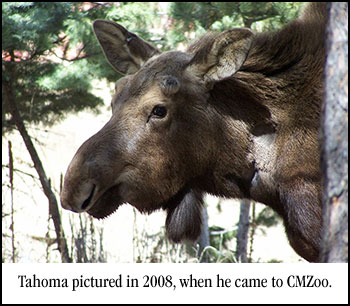
Tahoma came to Cheyenne Mountain Zoo as a 10-month-old calf, and immediately began making connections with guests in the newly opened Rocky Mountain Wild exhibit. Less than two weeks shy of his 13th birthday, due to chronic arthritis pain and other conditions that could no longer be controlled with medication and treatments, Tahoma’s care team made the difficult decision to humanely euthanize him. He passed peacefully on a soft bed of cedar shavings, surrounded by his loving keepers and vet staff. Tahoma spent nearly his entire life inspiring guests and staff at Cheyenne Mountain Zoo, and he will be remembered forever by those whose hearts he touched.
“All of our animals make an impact in their own way, but Tahoma took it above and beyond,” said Rebecca Zwicker, animal care manager in Rocky Mountain Wild, who worked with Tahoma for 10 years. “Before Tahoma, I never would have considered myself a ‘moose person,’ but he had me within the first minute of meeting him. I looked into those big brown eyes and handed him a cracker, and he nuzzled my hand and immediately had my heart. I can’t really put it into words, but there was something magic about Tahoma, and I know I’m not the only person who felt that.”
Zwicker and the rest of the Rocky Mountain Wild care team believe in the Zoo’s philosophy that our animals are our respected colleagues, and that we complete the work of the Zoo together as a team. We believe our animals are the essence of the Zoo. Our role is to help them succeed at their jobs, by providing the best possible habitats, health care, training, and opportunities for them to create meaningful relationships with our guests.
“Tahoma had this special way of connecting with people,” said Basia Dann, Rocky Mountain Wild animal keeper. “It was like he knew when we were busy and he needed to ‘work’ a little harder to reach more people. We would find huge crowds of people admiring him on busy days. He would position himself really close to people and create those opportunities for us to answer questions about moose and teach people about him to foster those important connections. That’s our job, and he was really good at it.”
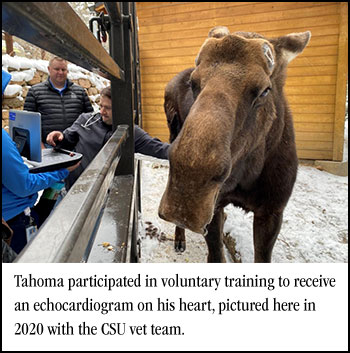
Tahoma was a quick study. Through positive reinforcement training, Tahoma and his keepers built a relationship that meant everyone could look forward to training sessions. It didn’t take him and his keepers long – sometimes just one day – to perfect voluntary injection training, ear cleaning sessions, x-rays, laser therapy, EKG readings and blood draws. Tahoma was a catalyst for Cheyenne Mountain Zoo’s renowned hoof care program. He was one of the first animals at the Zoo to voluntarily receive care on his hooves.
“I know for a fact what we learned from Tahoma has helped our giraffe,” said Zwicker. “There are other zoos in the U.S. that have started working with their moose because of the work we did with Tahoma. He was inspiring.”
Zwicker recalls sharing Tahoma’s achievements in hoof care to a room of three hundred people at an animal husbandry behaviors conference. That conference and another, during which zookeepers and trainers spent a day at Cheyenne Mountain Zoo and met Tahoma, led to somewhat of a celebrity status for him in the zoo community. Tahoma was photographed for National Geographic photographer Joel Satore’s ‘The Photo Ark’ series and was even featured in a popular outdoor clothing company’s advertising campaign.
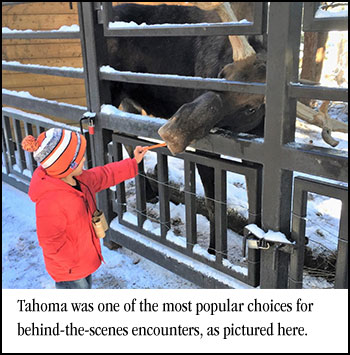
“He’s a legend,” said Sarah Dugger, Rocky Mountain Wild animal keeper. “I’ve been tracked down by keepers when I’m visiting other zoos just because I was Tahoma’s keeper. Even if they had never met him, they knew about Tahoma and had been inspired by him in some way. It wasn’t about meeting me; it was exciting for them to meet someone who worked with Tahoma.”
Tahoma made an enormous impact, and will leave a personal mark on so many lives. Thousands of people looked forward to guessing the weight of his antlers in Tahoma’s Annual Antler Weigh-In. He was motivation for a woman who had breast cancer and met her goal of visiting him once she went into remission. His face is tattooed on people’s bodies. He touched people’s hearts and expanded people’s horizons through education and the reminder that it’s always worth it to work to achieve a goal.
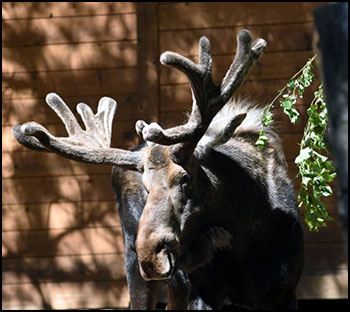
Although the Zoo was closed to the public on Tahoma’s last days, he was visited by his colleagues from every department at the Zoo.
“We showered him with love on his last few days,” said Zwicker. “It’s always a difficult decision, but we loved him too much to let the pain last. I’ve been thinking of our guests and how much they’re going to miss him, but want them all to know that he didn’t go out without any fanfare.”
Tahoma’s legacy will continue through the work of his fellow animal ambassadors, keepers, Cheyenne Mountain Zoo staff, the greater zoo and conservation communities, and the people who take action to protect wildlife and wild places because of the deep connections he made.
